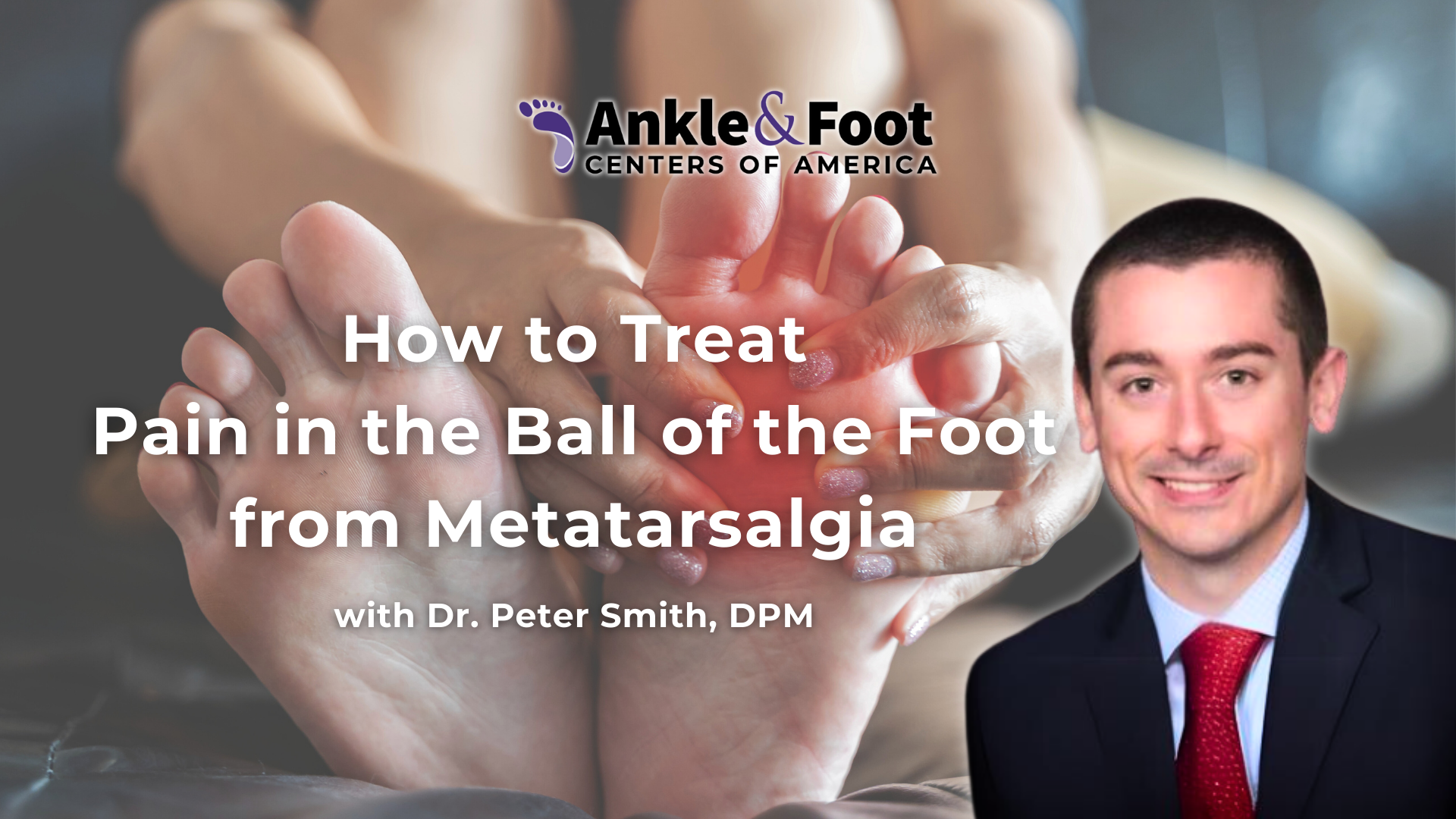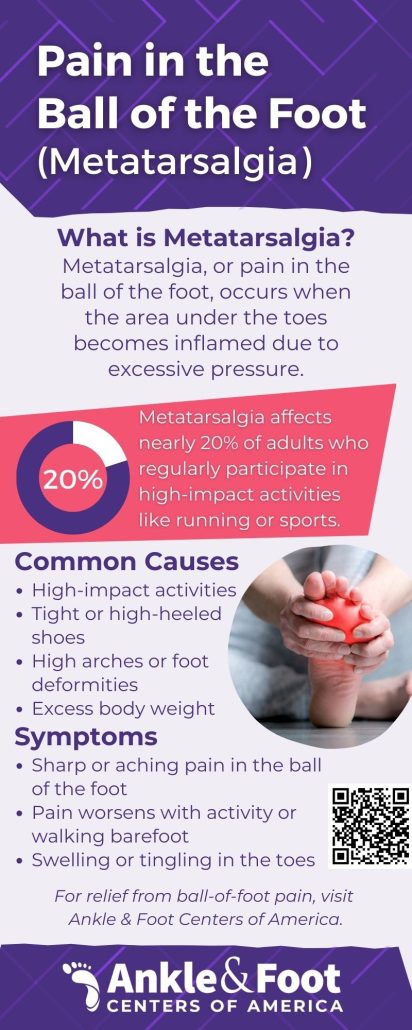Table of Contents
Introduction
Do you experience pain in the ball of your foot? It could be metatarsalgia. This condition affects the metatarsal area and causes discomfort, especially during walking or running. Foot pain like this can make daily tasks difficult and reduce your quality of life.
We’ll discuss exercises, insoles, and what to expect during recovery. If you’re wondering, “Does metatarsalgia ever go away?” or “How long does it take to heal?” — we’ve got you covered. With the right guidance, relief is possible!
What is Metatarsalgia?
Metatarsalgia is a condition that causes pain and inflammation in the ball of the foot. Typically, this discomfort occurs under the metatarsal bones, which connect the toes to the rest of the foot. People with metatarsalgia often describe the pain as sharp, burning, or aching.
There are several factors that can contribute to this condition. For example, wearing shoes that lack proper support, engaging in high-impact activities like running, or having foot abnormalities such as high arches or bunions can all increase the risk. Over time, these issues place excess pressure on the metatarsals, which eventually leads to pain.
The symptoms of metatarsalgia may include:
- Pain in the ball of the foot that worsens with activity.
- Tingling or numbness in the toes.
- A feeling of walking on a pebble or a bruise.
If left untreated, metatarsalgia can significantly affect mobility and quality of life. Therefore, consulting a podiatrist early can help identify the cause and provide relief through targeted treatments.
Immediate Relief for Metatarsalgia
When metatarsalgia causes pain in the ball of your foot, finding immediate relief is crucial. Fortunately, there are several simple and effective ways to ease discomfort right away:
Rest Your Feet
 First, stop activities that put pressure on your feet, such as running or standing for long periods. Resting helps reduce strain on the metatarsal area and prevents further pain.
First, stop activities that put pressure on your feet, such as running or standing for long periods. Resting helps reduce strain on the metatarsal area and prevents further pain.
Apply Ice Packs
Next, place an ice pack wrapped in a cloth on the painful area for 15–20 minutes. This not only reduces swelling but also numbs the pain, providing quick relief.
Elevate Your Feet
Additionally, lying down and elevating your feet above heart level improves blood flow and helps reduce inflammation.
Take Over-the-Counter Pain Relievers
Medications like ibuprofen or acetaminophen can also help temporarily relieve pain and reduce inflammation. However, always follow the recommended dosage and consult a doctor if needed.
Switch to Supportive Footwear
Finally, choose shoes with cushioning, a wide toe box, and proper arch support. Avoid high heels or narrow, tight shoes, as these can worsen the condition.
Treatment Options for Metatarsalgia
Treating metatarsalgia involves addressing the root causes of pain and using effective therapies to promote healing. Below are the most common and effective treatment options:
Custom Orthotics and Insoles
 A podiatrist can create custom orthotics tailored to your foot’s shape. These provide support, reduce pressure on the metatarsals, and improve overall foot alignment. Over-the-counter insoles designed for metatarsalgia can also be helpful for mild cases.
A podiatrist can create custom orthotics tailored to your foot’s shape. These provide support, reduce pressure on the metatarsals, and improve overall foot alignment. Over-the-counter insoles designed for metatarsalgia can also be helpful for mild cases.
Metatarsal Pads
Metatarsal pads are an affordable and simple solution. By redistributing weight across the foot, these pads reduce pressure on the ball of the foot and alleviate pain.
Physical Therapy for Metatarsalgia
Physical therapy can strengthen foot muscles and improve flexibility. Therapists often recommend targeted exercises to stretch and strengthen the toes and arch, which can help reduce stress on the metatarsals.
Metatarsalgia Exercises
Specific exercises, such as towel scrunches, toe stretches, and calf stretches, can improve foot mechanics and provide relief. These exercises also prevent future issues by strengthening the foot and reducing strain.
Proper Footwear
Switching to footwear with a wide toe box, adequate cushioning, and good arch support can significantly reduce discomfort. Avoid high heels and shoes with narrow toe boxes, as they exacerbate metatarsalgia symptoms.
Medications and Injections
Over-the-counter pain relievers, such as ibuprofen, can help manage inflammation and discomfort. In severe cases, podiatrists may recommend corticosteroid injections to reduce inflammation and pain.
Surgical Intervention
If conservative treatments fail, surgery may be considered. Procedures like metatarsal realignment or nerve decompression can address underlying structural issues. Surgery is typically a last resort and should be discussed thoroughly with a podiatrist.
By exploring these treatment options, patients can find a solution tailored to their needs. However, it’s essential to consult a podiatrist to determine the best course of action. Addressing metatarsalgia early can lead to faster recovery and a better quality of life.

FAQs About Metatarsalgia Recovery
 1. Does metatarsalgia ever go away?
1. Does metatarsalgia ever go away?
Yes, metatarsalgia can go away with proper treatment and care. Resting the feet, wearing supportive footwear, using metatarsal pads, and following a podiatrist’s recommendations can significantly reduce symptoms over time.
2. How long does it take for metatarsalgia to heal?
The recovery time for metatarsalgia varies depending on the severity of the condition and the treatment approach. Mild cases may improve within a few weeks, while more severe cases can take several months. Following a comprehensive treatment plan can speed up the healing process.
3. What can I do to speed up recovery?
To recover faster:
- Rest your feet and avoid activities that cause pain.
- Use ice packs to reduce swelling.
- Wear shoes with proper cushioning and support.
- Perform recommended metatarsalgia exercises to strengthen the foot.
- See a podiatrist for custom orthotics if needed.
4. Can metatarsalgia return after recovery?
Yes, metatarsalgia can return if the underlying causes aren’t addressed. Wearing unsupportive footwear, engaging in high-impact activities, or neglecting foot care can increase the risk of recurrence. Preventive measures, such as using proper footwear and maintaining a healthy weight, are key.
5. When should I see a podiatrist?
You should see a podiatrist if:
- The pain persists despite home treatments.
- Walking or daily activities become difficult.
- There is swelling or numbness in the foot.
- Symptoms worsen over time.
6. Can physical therapy help with recovery?
Yes, physical therapy is an effective way to improve flexibility and strengthen the muscles in the foot. A therapist can guide you through exercises that reduce stress on the metatarsal area and prevent future issues.
7. Will I need surgery for metatarsalgia?
Surgery is rarely needed for metatarsalgia. It is typically considered only when conservative treatments fail and the pain severely affects mobility. A podiatrist will determine if surgical intervention is necessary.
When to See a Specialist
 While mild cases of metatarsalgia often improve with rest and home treatments, there are times when professional care is essential. A podiatrist can diagnose the condition accurately and provide tailored treatment options. Here are signs that it’s time to see a specialist:
While mild cases of metatarsalgia often improve with rest and home treatments, there are times when professional care is essential. A podiatrist can diagnose the condition accurately and provide tailored treatment options. Here are signs that it’s time to see a specialist:
Persistent Pain
If the pain in the ball of your foot doesn’t improve after several weeks of self-care, it’s crucial to seek professional help. Persistent discomfort may indicate a more serious underlying issue.
Difficulty Walking or Performing Daily Activities
Severe metatarsalgia can interfere with walking, exercising, or even standing for extended periods. If your mobility is affected, a podiatrist can recommend effective solutions.
Swelling, Numbness, or Tingling
These symptoms may suggest nerve involvement or other complications requiring specialized care. A podiatrist can evaluate these issues and prevent further damage.
Worsening Symptoms
If your symptoms progressively worsen despite rest and treatment, it’s important to consult a specialist. This could signal a more advanced condition that needs medical attention.
Foot Deformities or Structural Issues
Conditions such as high arches, bunions, or hammertoes can contribute to metatarsalgia. A podiatrist can address these structural problems to alleviate pain.
Need for Custom Orthotics or Advanced Treatments
Over-the-counter insoles may not be enough for severe cases. A specialist can design custom orthotics or recommend advanced treatments tailored to your specific needs.
Concerns About Long-Term Recovery
If you’re unsure about how to recover fully or prevent recurrence, consulting a podiatrist can provide clarity. Specialists can guide you through exercises, footwear choices, and lifestyle adjustments.
By seeing a specialist at the right time, you can prevent the condition from worsening and achieve faster relief. At Ankle & Foot Centers of America, our podiatrists are ready to help you manage metatarsalgia effectively and get back on your feet pain-free.
Conclusion
Metatarsalgia can be a painful and frustrating condition, but with the right care, relief is possible. By addressing the underlying causes and following a tailored treatment plan, you can alleviate pain and improve your quality of life. Whether you choose metatarsal pads, custom orthotics, physical therapy, or specific exercises, the key is to take proactive steps toward recovery.
If you’re struggling with persistent ball-of-foot pain, don’t wait to seek professional help. At Ankle & Foot Centers of America, our specialists are dedicated to providing personalized care and effective solutions. Schedule an appointment today and take the first step toward walking pain-free again. Your feet will thank you!


 1. Does metatarsalgia ever go away?
1. Does metatarsalgia ever go away?



